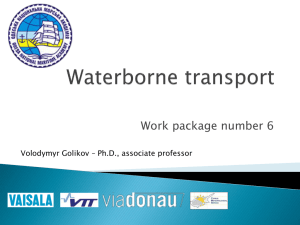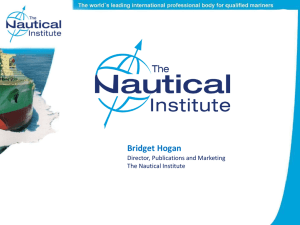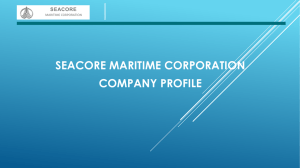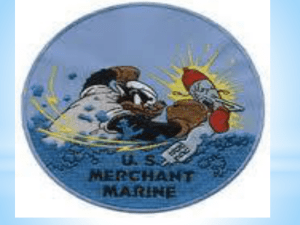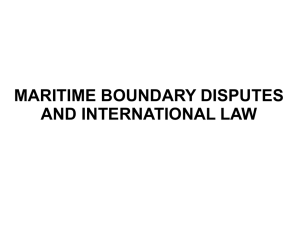Financial Analysis of California State University, Maritime
advertisement
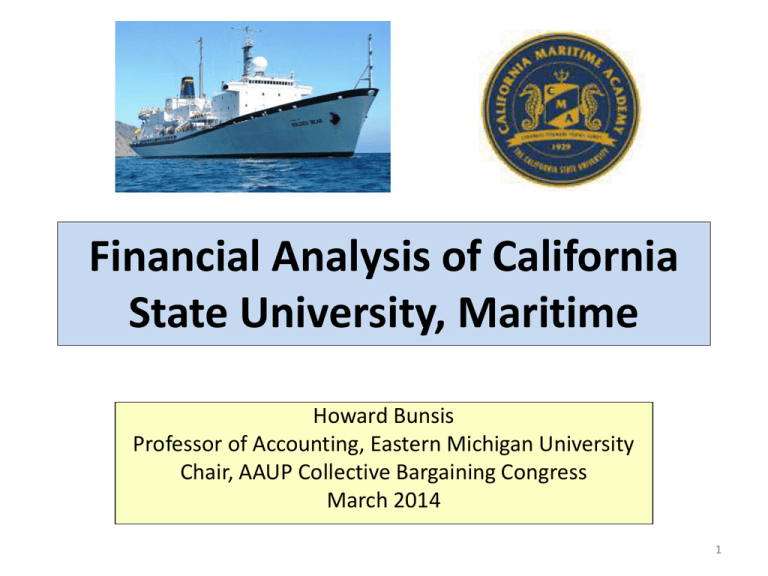
Financial Analysis of California State University, Maritime Howard Bunsis Professor of Accounting, Eastern Michigan University Chair, AAUP Collective Bargaining Congress March 2014 1 Financial Condition of Cal Maritime – Ratio Analysis 2 Three main topics: • CMA is financially in very good shape looking at reserves , cash flows and revenues • In spite of that, they are spending their money on things other than instruction and faculty. • CMA has enough money for equity 3, increase in cruise salaries, increase in international program salaries, putting money into ship’s ventilation system, and other items. Cal Maritime Net Asset Detail Source: CSU Audited Financial Statements Total Assets Total Liabilities Total Net Assets 2008 2009 2010 2011 2012 2013 75,466,046 87,456,524 86,576,065 89,344,855 89,812,000 114,682,000 16,323,945 29,143,522 22,771,398 22,471,696 21,933,000 41,369,000 59,142,101 58,313,002 63,804,667 66,873,159 67,879,000 73,313,000 Components of Net Assets Nonexpendable 50,022,575 51,433,618 51,232,231 51,082,314 51,434,000 0 0 0 0 0 48,508,000 0 Expendable 2,114,966 4,402,000 12,553,000 Unrestricted Total Net Assets 7,004,560 4,691,197 9,084,921 12,793,595 12,043,000 59,142,101 58,313,002 63,804,667 66,873,159 67,879,000 12,252,000 73,313,000 Invested in Capital 2,188,187 3,487,515 2,997,250 • The first two categories of net assets do not tell us anything about the financial health or flexibility of CSUM • The latter two categories – expendable and unrestricted, tell us something, as they are the two components of reserves 4 Cal Maritime Reserves Source: CSU Audited financial Statements 30,000,000 25,000,000 20,000,000 15,000,000 Restricted Expendable 10,000,000 Unrestricted 5,000,000 0 8 09 10 11 12 13 0 20 20 20 20 20 20 5 Cal Maritime Reserves in Context 2008 2009 2010 2011 2012 Unrestricted 7,004,560 4,691,197 9,084,921 12,793,595 12,043,000 Restricted Expendable 2,114,966 2,188,187 3,487,515 2,997,250 4,402,000 Total Reserves 9,119,526 6,879,384 12,572,436 15,790,845 16,445,000 Total Expenses 32,344,933 35,056,842 34,398,506 40,485,662 41,755,000 Primary Reserve Ratio 28% 20% 37% 39% 39% Primary Reserve Ratio based on Unrestricted Only 22% 13% 26% 32% 29% • • • • • For reserves, we need context: How large is $24.8 Million? We compare reserves to total expenses, creating the primary reserve ratio, which is defined as reserves over total expenses. Total expenses is a proxy for the size of the university The increase from 2012 to 2013 was due to increase in funds for the capital PA project Many also analyze the ratio using just unrestricted reserves in the numerator, which the last row reports What is a good primary reserve ratio? See next slide 2013 12,252,000 12,553,000 24,805,000 46,286,000 54% 26% Furlough Period 2009-10 6 Primary Reserve Ratio in Context 7 Data Behind Cash Flows Sources: CSU Audited Statements and IPEDS Cash flows from: Operatiions 2008 2009 2010 2011 2012 2013 (16,750,095) (20,634,000) (20,726,000) Noncapital financing (mostly State Appropriation) 22,767,011 0 Interest Paid 19,117,344 (87,351) 25,346,000 (745,000) 3,763,061 see below 2,279,898 Operaring Cash Flows (19,003,950) 30,188,000 (2,104,000) see below 3,967,000 7,358,000 For 2009 and 2011, since we do not have campus financial statements, we use IPEDS to estimate cash flows: Operating Revenues Operating Expenses Add back non-cash depreciation expense Operating cash flows Operating Cash Flows Total Revenues Cash Flow Ratio 2009 30,590,365 35,056,842 2011 38,518,185 40,485,662 2,368,418 (2,098,059) 3,317,390 1,349,913 2013 2012 2011 2010 2009 2008 3,763,061 (2,098,059) 2,279,898 1,349,913 3,967,000 7,358,000 38,308,072 34,227,793 39,890,171 42,440,948 42,761,000 51,720,000 9.8% -6.1% 5.7% 3.2% 9.3% 14.2% 8 Cash Flow Ratio in Context 9 Discussion of Cash Flows • The two strongest factors in concluding that Cal Maritime is in strong financial position are the reserves and cash flows. • Operating cash flows considers: – All cash in, from the state, tuition, grants, contracts, – Less all cash out, to employees, benefits, vendors, utilities • In 2013, CSUM had over $7.3 million in operating cash flows; this is a large surplus in the context of the size of the institution. • In years prior to 2012, cash flows have been strong as well. • The down year was 2009, which is expected. • The method used to estimate cash flows in 2009 and 2011 was very conservative, and likely under-estimated operating cash flows in those years. • Bottom line: The administration is generating significant excess operating cash flows every year, and we will see that the small amount of additional compensation requested for TSGB is well within the surpluses being generated. 10 What Do We Learn from the Ratios? • The ratios tell us that up through 2013, Cal Maritime is in solid financial condition – and in better condition than the CSU System as a whole. This conclusion is based on solid reserves and very strong cash flows. • Does this mean the administration should spend the reserves? No. Reserves are there for a rainy day, and there is a minimum level of reserves that should be kept (primary reserve ratio of 20%). • Still, any claims that there is no money, or that we must make future cuts, are dubious at best. • We will soon analyze what is happening going forward; but there definitely are sufficient resources for new projects and initiatives, as well as additional compensation for TSGB activities 11 Cal Maritime Revenue Analysis 12 Total Cal Maritime Revenues Over Time 60,000,000 Source: CSU Audited Financial Statements Large increase in 2013 was mostly due to a large increase in tuition revenue 50,000,000 40,000,000 30,000,000 20,000,000 10,000,000 0 2008 2009 2010 2011 2012 2013 13 Percentage Change in State Appropriation: CSU System vs. Cal Maritime 20% Source: CSU Audited Financial Statements 10% 0% -10% Cal Mari me CSU System -20% -30% -40% 2008 to 2009 to 2010 to 2011 to 2012 to 2013 2012 2011 2010 2009 2008 to 2013 • The changes for the entire system were more negative than for CSUM • Over the long term (2008 to 2013), the change for Maritime is actually positive, versus -30% for the system as a whole 14 Priorities of the Administration: Are They Being True to the Core Academic Mission? 15 CSUM Expense Distribution Source: OUS Audited Financial Statements Instruction 2008 32.0% 2009 32.5% 2010 31.9% 2011 32.6% 2012 30.6% 2013 26.7% Research Public Service 0.8% 0.0% 0.5% 0.0% 1.2% 0.0% 1.4% 0.0% 5.5% 0.0% 4.6% 0.0% Academic Support Student Services 4.7% 11.3% 5.5% 11.5% 4.8% 11.0% 4.4% 11.1% 4.0% 11.7% 4.3% 10.8% Institutional Support Plant 19.2% 13.7% 17.6% 13.5% 17.1% 11.6% 14.9% 10.6% 14.3% 8.9% 13.1% 13.4% Scholarships Auxiliaries Depreciation 0.1% 12.0% 6.1% 1.6% 9.9% 6.8% 1.7% 10.0% 8.5% 2.3% 12.7% 8.2% 2.7% 12.3% 8.3% 5.8% 10.1% 8.0% Interest Total Expenses 0.0% 100.0% 0.8% 100.0% 2.2% 100.0% 1.8% 100.0% 1.8% 100.0% 3.1% 100.0% • • Not even $1 of every $3 goes to instruction The percent devoted to instruction has gone down over time, including a large drop from 2012 to 2013 16 Cal Maritime Total Salaries and Benefits in Context: Source: IPEDS (Integrated Postsecondary Education Data System of the US Dept. of Education) IPEDS data is only available through 2012 2008 2009 2010 2011 2012 Total Salaries 15,207,505 15,653,885 14,332,813 15,949,038 15,824,310 Total Benefits 5,314,043 Total Salaries and Benefits 20,521,548 21,468,098 19,999,409 22,476,402 22,218,188 5,814,213 5,666,596 6,527,364 6,393,878 Total Cal Maritime Expenses 32,344,933 35,056,842 34,398,506 40,485,662 41,755,000 Salaries + Benefits as a Percent of Total CSUM Expenses 63% 61% 58% 56% 53% • • For Cal Maritime, personnel costs are 53% of total expenses, down from 63% just 5 years ago There has been a much larger increase in benefits costs than in salary costs 17 Comparison of Top CSUM Administrative Salaries Over Time Source: http://www.sacbee.com/statepay/#req=employee%2Ftop%2Fyear%3D2013 Position Rank President President Past President Administrator IV Provost Administrator IV VP Admin and Finance Administrator IV VP Univ Advancement Administrator IV Dean Administrator III VP Student Affairs Administrator IV Master TS Golden Bear; Dir L/Dev Administrator III Assoc Vice Pres Fin. Services Administrator III Exec Director Human Resources Administrator III Director of GBF Facilities Operation Administrator III Dean of Students Administrator III Director, Student Health Services Administrator III University Planner Administrator III Comptroller Administrator III 1st Engineer TSGB Administrator III Director of Facilities Operations Administrator III Chief of Police Administrator III Admissions Administrator III Director, Athletics Administrator II • • 2009 2010 2011 $264,000 $77,600 $259,000 $189,000 $274,000 $200,000 $139,000 $140,000 $99,000 $135,000 $137,000 $96,600 $144,000 $145,000 $126,000 $133,000 $93,200 $100,000 $90,000 $129,000 $45,900 $95,300 $90,800 $97,200 $104,000 $138,000 $130,000 $160,000 $96,800 $103,000 $104,000 $100,000 $92,900 $90,600 $100,000 $90,500 $88,200 $100,000 $96,100 $93,900 In 2012, 13 administrators made more than $100,000 (the number would likely have been 15 if positions were filled all year) In 2013, 18 administrators made more than $100,000 2012 $110,000 $243,000 $200,000 $135,000 $117,000 $60,600 $144,000 $145,000 $132,000 $40,500 $138,000 $130,000 $160,000 $96,800 $108,000 $95,700 $93,200 $100,000 $96,100 $93,900 2013 $263,000 $177,000 $202,000 $173,000 $165,000 $160,000 $155,000 $146,000 $143,000 $143,000 $140,000 $131,000 $127,000 $123,000 $113,000 $108,000 $102,000 $101,000 $97,300 $95,300 18 Number of Employees, FTE Basis Source: http://www.calstate.edu/budget/final-budget-summaries/ 2014-15 2007-08 2008-09 2009-10 2010-11 2011-12 2012-13 2013-14 Proposed Management 34.4 36.5 36.2 35.7 37.7 43.1 44.9 44.9 Academic 78.9 77.1 77.3 75.6 76.7 79.5 82.7 82.7 Support Staff 117.7 143.3 137.7 138.4 138.2 143.5 175.1 175.1 Total 231.0 256.9 251.2 249.7 252.6 266.1 302.7 302.7 Ratio of Management to Faculty 0.44 0.47 0.47 0.47 0.49 0.54 0.54 0.54 • • Number of management employees over the number of academic employees. We will compare this to the other CSU institutions It is not appropriate that this ratio is increasing over time 19 Enrollment Details: By Major 07-13 Source: h J p://www.csum.edu/web/registrar/enrollment Fall 2007 Fall 2008 Fall 2009 Fall 2010 Fall 2011 Fall 2012 Fall 2013 83 34 77 157 310 131 0 35 0 827 67 29 107 141 331 135 0 1 65 876 68 25 102 155 328 144 0 1 0 823 101 17 112 166 324 114 21 2 0 857 116 22 102 165 318 133 31 2 0 889 137 29 112 199 312 155 31 1 0 976 142 47 127 193 323 206 7 1 0 1,046 Number Percent Business Administration 59 71% 14% Facilities Engineering Tech 13 50 36 13 38% 65% 23% 4% 4% Business Administration Facilities Engineering Tech Global Studies & Maritime Aff Marine Engineering Technology Marine Transportation Mechanical Engineering H License Track Mechanical Engineering H Unlicense Track Undeclared Undeclared (Cruise) Total Changes, Fall 2007 to Fall 2013 Global Studies & Maritime Aff Marine Engineering Technology Marine Transportation Mechanical Engineering H License Track All Other Total Change From 2007 to 2013 75 (27) 219 57% % of Total, Fall 13 18% 31% 20% Marine Transportation is the largest major 12% 1% +26% • • • ME grew largest in # Business grew largest in % 20 Instructional Salaries and Benefits Compared to Total Expenses per IPEDS 2008 2009 2010 2011 2012 Instruction Salaries + Benefits 8,577,505 8,527,508 7,786,024 8,998,195 8,174,271 Total Cal Maritime Expenses 32,344,933 35,056,842 34,398,506 40,485,662 41,755,000 26.5% 24.3% 22.6% 22.2% 19.6% Instruction Salaries + Benefits as a % of Total Cal Maritime Expenses • That is right: Only 19.6 cents of every dollar goes to pay people who teach class • When the 2013 IPEDS data gets reported in April of 2014. we will see if this 19.6% actually got lower 21 Percentage Change in the Number of Employees by Category: 2007-08 to 2013-14 Source: http://www.calstate.edu/budget/final-budget-summaries/ 60% 50% 49% 40% 31% 30% 26% 20% 10% 5% 0% Support Staff Management Enrollment Academic 22 0.00 Mari me Channel Islands Bakersfield Monterey Bay Sonoma Humboldt Chico San Marcos East Bay San Diego State Pomona Polytechnic San Bernardino Fullerton Sacramento Dominguez Hills Stanislaus San Jose LA San Francisco Northridge Fresno Long Beach Ratio of Management Employees to Academic Employees, All CSU Institutions Source: http://www.calstate.edu/budget/final-budget-summaries/ 0.60 0.50 0.40 0.30 0.20 0.10 23 Data For Ratio of Management Employees to Academic Employees Source: http://www.calstate.edu/budget/final-budget-summaries/ Campus: Maritime Channel Islands Bakersfield Monterey Bay Sonoma Humboldt Chico San Marcos East Bay San Diego State Pomona Polytechnic San Bernardino Fullerton Sacramento Dominguez Hills Stanislaus San Jose LA San Francisco Northridge Fresno Long Beach Ratio 0.54 0.39 0.31 0.30 0.26 0.21 0.19 0.19 0.18 0.17 0.16 0.16 0.16 0.16 0.16 0.16 0.15 0.13 0.13 0.13 0.12 0.12 0.09 Academic 82.7 229.6 363.4 299.3 429.8 380.9 686.7 491.9 535.6 1,316.5 810.1 1,025.9 644.2 1,401.6 1,013.6 571.6 406.8 1,277.2 979.3 1,149.7 1,474.4 924.1 1,552.9 MGMT 44.9 88.9 111.5 90.1 113.4 78.1 131.9 93.1 97.5 223.4 133.1 167.7 103.3 220.4 158.7 89.2 61.5 167.3 127.4 144.4 178.1 108.9 146.7 Averages w/o Maritime Median w/o Maritime 0.18 0.16 816.6 748.4 128.8 120.4 • Maritime is by far the smallest institution, and the ratio is going to be higher • However, the number of upper level administrators seems high even for the size of Maritime; Stanislaus has only 16 more admins, but has 325 more academic instructors 24 Cal Maritime 2013 Faculty Salaries vs. Peers- Levels Sources: AAUP Salary Survey and IPEDS 2013 Texas A&M Galveston Maine Maritime Cal Maritime Ferris State SUNY Maritime Masschusetts Maritime Full $105,894 $93,996 $93,423 $91,799 $86,356 $83,961 Associate $70,659 $72,063 $76,671 $74,328 $77,289 $64,593 Assistant $67,374 $57,015 $63,815 $66,443 $61,985 $57,510 Cal Maritime rank (of 6) Mean w/o Cal Maritime 3 $92,401 2 $71,786 3 $62,065 Cal Maritime vs. Mean $1,022 $4,885 $1,749 • Very few of the comparable institutions reported instructor and lecturer salaries; historically, that data has not been reliable, as different institutions use different definitions for those categories • Ferris State and Galveston data is for the entire university 25 Cal Maritime Faculty Salaries vs. Peers - Changes from 2008 to 2013 Sources: AAUP Salary Survey and IPEDS Cal Maritime Averages, 2008 Peer Average w/o Cal Maritime, 2008 Cal Maritime 2008 Rank (out of 6) Ranking Gain (Loss) from 2008 to 2013 Cal Maritime vs. Peer Average, 2008 $$ Gain (Loss) vs. Peers from 2008 to 2013 % Loss vs. Peers from 2008 to 2013 Full Associate Assistant $90,477 $84,193 $63,054 $80,720 $63,359 $56,270 2 1 2 -1 -1 -1 $9,757 $20,834 $6,784 ($8,736) ($15,950) ($5,035) -9.7% -18.9% -8.0% 26 Discussion of Faculty Salaries • In terms of levels, salaries for Cal Maritime faculty have not increased much over time. The associate professor salary in 2008 may be high, but Associates has not seen large increases over the last few years • In terms of peers, Cal Maritime faculty are now middle of the pack, after having been significantly ahead of these peers just a few years ago. Given the cost of living in this area, and general inflation, faculty salaries have not done well over the last several years • In general, efforts should be made to move faculty salaries to an appropriate place versus peers, and consider the cost of living generally and the cost of living in California versus other states. The resources exist for this to happen. 27 See The Report • www.calfac.org\calmaritime Conclusions The Financial Condition of CSU System and the State of CA • Appropriation and enrollment in 2014 and 2015 are up for the CSU System, and state tax revenues are higher Financial Condition of Cal Maritime • Despite a huge decline in the state appropriation, reserves and cash flows are very solid. • Any claim of financial hardship are not supported by the evidence – CSUM is NOT BROKE! Priorities of the Administration • The number of Cal Maritime administrators has increased, especially when compared to faculty • Pay for faculty is lagging peers 29
